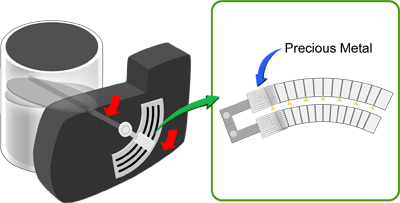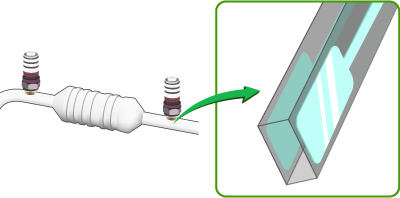Products and Solutions

Precious Metals Support the Future of Automobiles
We explain the surprising role that precious metals play in cars.
Current Circumstances surrounding Automobiles
Automobiles use many components made from metals including steel, aluminum, and copper, but did you know that many parts also contain precious metals? Below, we explain the surprising role that precious metals play in cars.
Automobiles are industrial products that are a source of pride for Japan. As they have become more common, cars have enhanced the quality of our lives. However they have also given rise to various problems including the depletion of energy resources, global warming, environmental pollution, and safety issues. There are many prominent efforts to address preservation of the global environment including improving fuel efficiency and making emissions cleaner. Since the United States established automobile emissions standards in the 1960s, the automobile industry has complied with increasingly stringent regulations using advanced technology. In addition, technological innovation for automobiles are in continuous demand as the The Euro 6 regulations came into effect in EU countries in September 2014 with even stricter controls on emissions of particulate matter (PM) and nitrogen oxides (NOx). These developments are occurring not only in developed countries, but are also expanding to countries that are undergoing motorization such as China, Thailand, Brazil and other regions.
General sales of next-generation automobiles such as electric vehicles and fuel cell vehicles have begun, and the circumstances surrounding automobiles are about to enter a period of major change. In 2010, global auto production was 80 million vehicles, and this number is expected to increase to 200 million by 2050. Annual production of vehicles with reciprocating engines including hybrid vehicles is expected to reach 130 million vehicles by 2040. Related businesses within the expanding automotive market are also expected to grow 40% by 2040 compared to 2010.

Energy Technology Perspectives: Mitigation Potential in Transport, Presentation COP 20 side-event, 4th December, Lima, Peru,;
http://www.iea.org/media/workshops/2014/cop20/PHILIBERT_GAGNE_Transport_day_Lima.pdf; IEA Publishing.
Licence: http://www.iea.org/t&c/termsandconditions/
The Roles of Precious Metals that are Essential for Automobiles
As automobile markets around the world continue to expand, increasingly stringent requirements will be imposed on cars including the use of fewer resources, emissions reduction, and improved safety and comfort.
As power units have become increasingly diversified in recent years, greater demands are being made including direct-injection engines, downsized supercharged engines, clean diesel engines, and hybrid systems. In addition, demands for better fuel efficiency, output performance, durability and reliability that maintain performance under the harshest environments, and enhanced environmental performance that reduces environmental pollutants in emissions to the point of rendering vehicles harmless. Precious metals are used in various automobile parts to meet these broad-ranging demands.
Engine Units
The automobile parts that use the most precious metals are the engine units, the heart of the automobile. Precious metals are found in the fuel pump unit that supplies fuel to the engine, sensors that measure the amount of fuel, fuel injection equipment and spark plugs that ignite the fuel-air mixture in the engine combustion chamber. They are also used in the emissions sensors and oxygen sensors that prevent environmental pollutants in emissions including hydrocarbons (HC), carbon monoxide (CO), nitrogen oxides (NOx), and particulate matter (PM) from being released. The engine control unit (ECU) that controls the engine to maintain optimal conditions and the numerous sensors that detect and measure various information that the ECU requires to function also use precious metals.
*Click on part description for more details

[Main Parts that Use Precious Metals]
Switches
Relays, which detect the on/off status of various switches or the position of multi-staged switches used for various convenient devices such as power windows and air-conditioning uses precious metals to allow electricity to flow. The number of such relays are increasing as they have the high reliability to withstand extreme temperature differences in the vehicle interior ranging from -30°C to 90°C. In addition, electrical contacts that use precious metals have superior conductivity, durability, and reliability and are compatible with a wide range of loads starting from minute currents.
*Click on part description for more details

[Main Parts that Use Precious Metals]
Other Parts
A wide range of automobile parts use precious metals.
*Click on part description for more details

[Main Parts that Use Precious Metals]
Recycling
Precious metals are used in various automobile parts as discussed above, the end-of-life vehicles become a valuable resource through recycling. There are 3 to 7 g of platinum in one ton of natural ore, about the amount in a single ring and enough for about four entire automobiles including the catalyst used in emissions purification systems. (Recovery and refining, recycling of spent automobile catalysts)
The Mission Carried out by TANAKA in the Automobile Sector
As the use of IT and electrical equipment in automobiles increases, precious metals will continue to play a major role as a raw material used in auto parts. Even more precious metals will be needed as higher environmental performance is demanded and the number of vehicles continues to grow. Under the circumstances, stable supplies of precious metals and cost reductions are crucial to maintain automobile production.
TANAKA is committed to providing total solutions throughout the entire resource cycle from procurement of bullion to processing and supply of materials to recycling. We are also conducting ongoing research so we can offer exceptional cost performance by reducing the amount of precious metals used through pinpoint application of precious metals where needed. We hope to contribute to the future of automobiles through the use of new products and advanced technological capabilities that maximize the characteristics of precious materials
*Reference literature, and data
- International Energy Agency http://www.iea.org
- Japan Automobile Manufacturers Association, Inc. Website http://www.jama-english.jp
- Society of Automotive Engineers of Japan, Inc., Japanese-English dictionary of automobile terminology
- Dai-sharin, Modern Automotive Terms Explained, San-eishobo Publishing Co., Ltd.















